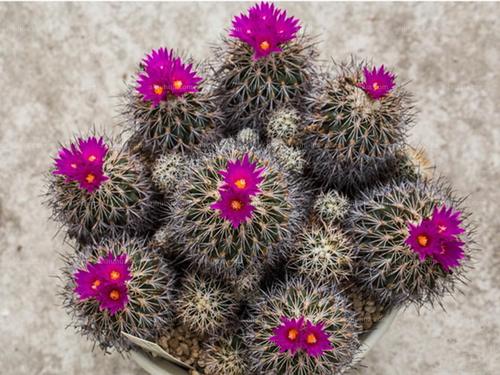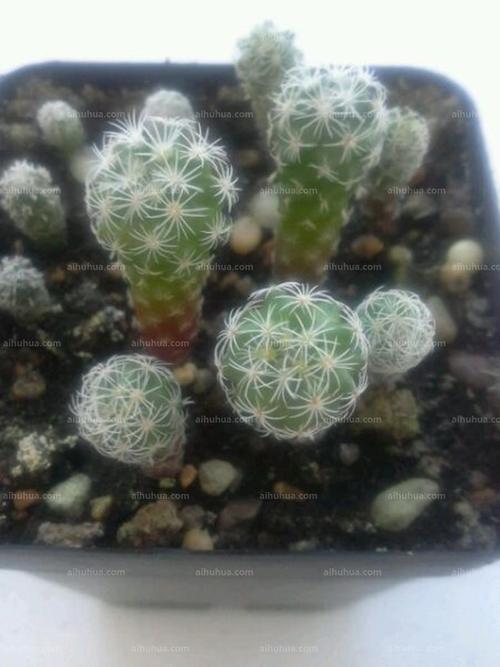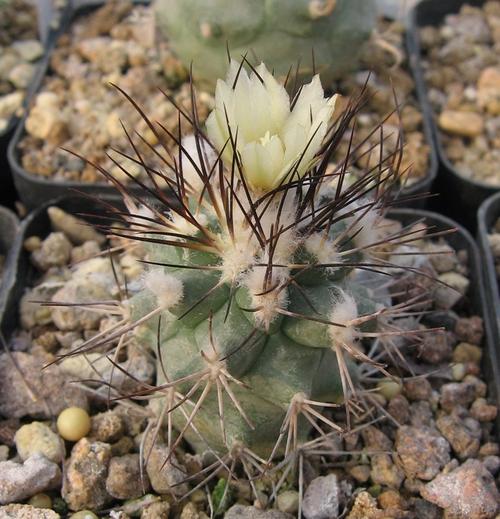Turbinicarpus horripilus profile
Written by Maggie
Mar 18 2021

Turbinicarpus horripilus is spherical, with blue-green skin. All edges are divided into verrucous processes. Aciculate spines are white, tip brown. Flowers are apical, deep rose red.
Turbinicarpus horripilus picture

Morphological characteristics of Turbinicarpus horripilus
Turbinicarpus horripilus is spherical and has bluish-green skin. All edges are divided into verrucous processes. Aciculate spines are white, tip brown. Flowers are apical, deep rose red.
The ecological habits of Turbinicarpus horripilus
Turbinicarpus horripilus is a very robust variety that grows fairly quickly and requires well-drained soil. Adequate sunshine and control of watering, to keep the plant compact, watering attention not to touch the ball to ensure the color of white hair, to ensure good ventilation and heat. In winter or at night, the temperature is best not less than 10℃, in dry conditions, it can be a short time cold -4℃.
The cultivation of Turbinicarpus horripilus
Turbinicarpus horripilus propagates by seed. turbinicarpus horripilus is a very robust variety that grows fairly quickly and requires well-drained soil. Adequate sunshine and control of watering, to keep the plant compact, watering attention not to touch the ball to ensure the color of white hair, to ensure good ventilation and heat, in winter or at night, the temperature is best not less than 10℃, in dry conditions, can be a short time cold -4℃.
Disease & pest control of Turbinicarpus horripilus
The main diseases and insect pests of Turbinicarpus horripilus and their prevention and control measures, the main diseases and insect pests are bacterial perforation disease, gum disease, brown rot, anthrax, ball fungus, apricot whitlow disease and so on.
In winter, the glue should be removed, the tree trunk should be whitened, the wound should be disinfected with 5 Paume sulfur mixture, and the wound should be protected with wax. Before germination we need to spray 5 Baume degree sulphur mixture, to prevent brown rot, anthrax, ball hard scale, apricot whitlow disease; In spring, spray 1 time of carbendazim or retreat fungus special 400 times or use 65% of mancozeb 400-500 times liquid, prevention and control of brown rot, anthrax, can boil disease.

The distribution area of Turbinicarpus horripilus
Turbinicarpus Horripilus is distributed in Mexico.
Turbinicarpus horripilus uses
The collocation of household style
A lot of goodwife are buying plant of a few flowers in the home, act the role of the dress that resembles different style to act the role of collocation of different style same, the plant also needs to match with the style photograph in the home, ability lets small home icing on the cake. Turbinicarpus Horripilus, a species of cactus, is very popular. Originally from Mexico, Turbinicarpus horripilus is currently an endangered species of cactus.
Spherical, blue - green skin. All edges are divided into verrucous processes. Aciculate spines white, tip brown. Flowers are apical, deep rose red. The shape resembles red plum and gets its name. Like most cactuses, Turbinicarpus horripilus is pretty good at purifying the air and picking up dust.
Turbinicarpus horripilus is very easy to grow and very effective in traditional geomancy in China, so it is regarded as an auspicious plant. In geomancy application, Turbinicarpus horripilus is also very auspicious and has a positive and upward enthusiasm in home geomancy.Green is good for health, represents safety and peace of mind, and is good for the body.
From a modern scientific perspective, Turbinicarpus horripilus, a cactus that absorbs carbon dioxide at night and exhals oxygen, is also pretty clean for the air and radiation-proof, so it can be placed on the lake complex window terrace in front of your computer.
Turbinicarpus horripilus' blowhole opens at night, sucking in carbon dioxide and gelling out oxygen. In the home beside the electrical appliances put this plant, can effectively reduce the electromagnetic radiation pollution generated by all kinds of electrical and electronic products, so that the concentration of negative ions in the indoor air increases, so in the home beside the electrical appliances put this plant, can help the human body as far as possible to reduce the radiation released by the computer.
Application of geomancy
Turbinicarpus horripilus is pink to purple in color and flowers in spring and summer. Turbinicarpus horripilus is spherical and has bluish-green skin. All edges are divided into verrucous processes.Aciculate spines white, tip brown. Flowers are apical, deep rose red.
Their stomata are closed during the day to release oxygen and absorb carbon dioxide for gas exchange at night. They are stored in the daytime for photosynthesis. The thick leaves are conducive to the storage of more water and air and have the function of purifying air.
Turbinicarpus horripilus, a deep rose-red flower with a topmost bloom, so a lot of people like Turbinicarpus horripilus. PlacingTurbinicarpus horripilus in your home has a beautifying effect. Turbinicarpus horripilus is pretty compact, doesn't take up much space, and is easy to farm. Growing Turbinicarpus horripilus next to your computer also absorbs radiation, relaxing your eyes and protecting your vision.
Role in the Home
Turbinicarpus horripilus stomata are closed during the day to release oxygen and absorb carbon dioxide for gas exchange at night. They are stored in the daytime for photosynthesis. The thick leaves are conducive to the storage of more water and air and have the function of purifying air.
Turbinicarpus horripilus, a deep rose-red flower with a topmost bloom, so a lot of people like Turbinicarpus horripilus. PlacingTurbinicarpus horripilus in your home has a beautifying effect. Turbinicarpus horripilus is pretty compact, doesn't take up much space, and is easy to farm. Growing Turbinicarpus horripilus next to your computer also absorbs radiation, relaxing your eyes and protecting your vision.

Latest Updated
- Benefits of Bugleweed - 7 Science-backed Health Benefits
- Bugleweed Dangers & Side Effects - Is It Poisonous?
- How to Plant Evergreen Trees - What You Should Know
- When to Plant Evergreens - Grow Guide for Evergreen Trees
- 12 Wonderful Evergreen Shrubs for Your Garden
- 12 Popular Evergreen Plants with Pictures for Beginners
- When And How To Prune A Lilac Bush Like a Pro
- How to Grow & Care for Lilac Vine (Hardenbergia Violacea)
- Japanese Lilac Tree (Syringa Reticulata) Care & Propagation Guide
- Shumard Oak Pros and Cons - What to Know
Popular Articles
- Winter maintenance of Antirrhinum Majus
- How to Grow Terminalia Mantaly Tree
- How to Grow and Care for Crossostephium Chinense
- How to grow Antirrhinum Majus in spring
- Peristeria Elata (Dove Orchid) Profile: Info & Care Guide
- Underwatered Snake Plant (Sansevieria Trifasciata) - Signs And How To Fix
- How to Care for Brazilian Jasmine Plant (Mandevilla Sanderi)
- How to Grow & Care for Graptopetalum Purple Delight in Summer
- Rosa Chinensis (China Rose): Plant Growing & Care Tips
- How to Care for Baby Sun Rose (Aptenia Cordifolia)